Al Mahrah: Bearing the Brunt of Hurricanes and Climate Change
- 16 Jan 2024


With each advisory from meteorological agencies and hurricane monitoring centres in the Indian Ocean and the Arabian Sea, Yemen's focus narrows to two primary governorates vulnerable to potential hurricanes or atmospheric depressions: Socotra, the largest Arab archipelago situated at the intersection of these waters, and Al Mahrah, bordering the Sultanate of Oman and having endured considerable damages. What elevates Al Mahrah to a pivotal role concerning climate change and hurricane vulnerabilities? Furthermore, how might one assess the adequacy of governmental measures or responses to this looming threat?
Observing the Yemeni map reveals that the expansive coastal stretch of Al Mahrah Governorate, the second-largest area after Hadramaut, acts as a subsequent or adjacent point in the trajectory of severe hurricanes, extending further to Shabwa and Abyan Governorates. Conversely, the impact of depressions and tropical storms on other coastal Yemeni governorates is comparatively milder, as they experience secondary effects. The Horn of Africa serves as a natural barrier for these governorates, mitigating the intensity of certain hurricanes originating in the ocean.
It's essential to highlight that emphasising Al Mahrah Governorate or the hardest-hit regions doesn't imply that the repercussions of climate change associated with such transformations are confined solely to it. With every hurricane or depression Yemen experiences, the ramifications extend to coastal and inland governorates. Intense rainfall and torrential downpours from these events inflict diverse damages nationwide. Given Yemen's already vulnerable infrastructure as a developing country, numerous services experience significant disruptions.
Multiple Influences:
While the hurricanes and storms affecting Al Mahrah originate from natural occurrences beyond the country’s borders, their impact and management cannot be isolated from the broader context of Yemen's prevailing conditions. Specifically, the political landscape and demographic dynamics associated with the governorate are pivotal in shaping the response and repercussions.
From a demographic perspective, Al Mahrah historically ranked among the least densely populated governorates despite its vast expanse. Regarding services, it grappled with governmental neglect compounded by its geographically distant location from the state's administrative hubs, be it Aden before unification or post-reunification. The 1990 unification of Yemen further marginalised the region, depriving it of substantial service initiatives and infrastructure development.
Within this framework, it's crucial to highlight Al Mahrah's longstanding challenges regarding its road connectivity to other governorates. It wasn't until 2006 that a strategic road was inaugurated, coinciding with the region's notable developments over nearly two decades. During this period, the governorate attracted labourers, traders, and proprietors of medium to small-scale enterprises from diverse areas. Since 2015, Al Mahrah has experienced a surge in population influx due to its status as the sole governorate untouched by the intensifying war.
This significance has evolved further with the intervention of the coalition, notably led by the Kingdom of Saudi Arabia, coupled with the longstanding Omani influence predating this involvement. Beyond the ensuing political divisions, Al Mahrah received numerous Saudi-sponsored projects. Concurrently, the Yemeni government sustained its foothold in the governorate at multiple junctures, maintaining a more consistent presence compared to other regions where such presence dwindled.
Geographical Implications:
Al Mahrah boasts a predominantly arid and desertic climate, with soaring temperatures prevalent during the summer months. Topographically, the region can be delineated into three distinct zones: the Coastal Plain, the Central Plateau encompassing mountainous terrain, and the Northern Desert contiguous with the Rub' al Khali (Empty Quarter). The sequence of landscapes traverses from the Southern Coastal Plain to the Central Mountainous Plateaus and Culminates in the Northern desert. While hurricanes primarily affect the coastal regions (1), the governorate grapples with scanty rainfall, except the Hawf area, celebrated as a natural sanctuary among Yemen's most picturesque areas.
Considering Al Mahrah's tropical positioning and expansive coastline along the Arabian Sea, rendering it susceptible to hurricanes, it's imperative to contextualise its situation relative to Yemen's eastern neighbour. Al Mahrah shares borders with Oman, the Arab country most significantly impacted by hurricanes in recent years. Oman experienced its most severe hurricane in 2007, underscoring the shared vulnerability of coastal regions in this vicinity.
However, the shifting climate patterns have intensified Al Mahrah's susceptibility to unparalleled threats. Illustratively, in 2015 alone, the governorate confronted two formidable cyclones, "Meg" and the notably ferocious "Chapala." Subsequently, 2018 witnessed the onslaught of three cyclones: "Sagar," "Mekunu," and "Luban." This starkly contrasts with the preceding decade's tally, where Al Mahrah encountered a total of six cyclones between 2011 and 2020, compared to a mere three in the entirety of the previous decade: precisely, cyclones "Ariel" in 2001, "Gonu" in 2007, and " Phet" in 2010
Hurricanes in Al Mahrah have led to significant human casualties, with many fatalities and thousands left homeless. Each storm has wreaked havoc, with the damage often surpassing 90% of the infrastructure. Cyclone "Luban," for instance, devastated roads and obliterated vital utilities, including electricity and water networks, while damaging numerous homes (2). The more recent "Tej" caused the deaths of two individuals, injured 150, and inflicted substantial harm on public and private assets, including roads and communication systems. This storm also displaced around 10,000 residents from Al Ghaydah and Huswain, areas hit hardest by the disaster.
Abdel Nasser Kalshat, the head of the Fisheries General Authority in Al Mahrah, highlighted in a recent interview that hurricanes have significantly impacted public structures along the coast and the assets of fishermen. Despite their precautions, the sheer volume of water associated with these hurricanes alters flood patterns in certain areas. Estimates suggest that the fisheries sector, mainly the fishermen, have incurred losses exceeding one million dollars due to the most recent hurricane.
Limited Interventions
In the wake of the recent calamity in Al Mahrah Governorate, specifically Cyclone “Tej” in October 2023, official interventions became evident promptly. The Chairman of the Presidential Leadership Council, accompanied by several officials, visited the governorate soon after the disaster. They aimed to oversee response measures, assess damages, and provide essential guidance for recovery efforts. Before this, visits from the Prime Minister and other ministers were undertaken to ensure timely interventions and offer directives related to relief operations.
Overall, government initiatives primarily focus on pre-hurricane preparations. This includes establishing emergency committees and collaborating with local authorities, which then implement various measures and set up pertinent committees at the district level. However, there seems to be a gap in post-disaster response, particularly in terms of compensation, recovery efforts, and strategic infrastructure planning. It's essential that future infrastructure projects integrate considerations of climate risks to mitigate the direct repercussions of tropical hurricanes and depressions.
Local authority assessments indicate that hurricanes have inflicted approximately $139 million in damages to infrastructure and public assets. However, local officials express discontent with what they perceive as insufficient government response. While the local authority has taken steps such as erecting defences in parts of Al Ghaydah, the governorate's centre, and refurbishing educational and health facilities, roads, and bridges, affected individuals have yet to receive compensation. This has raised concerns, especially considering government committees and public statements that previously indicated otherwise.
Discussing the Yemeni government's response necessitates acknowledging the ongoing challenges the nation has faced for years. Within this context, the relief and developmental contributions of the coalition, primarily Saudi Arabia and the UAE in Al Mahrah, become significant. Additionally, Oman's relief efforts, grounded in its geographic proximity, are noteworthy. However, despite these contributions, Al Mahrah continues to grapple with significant challenges, with a lack of effective interventions addressing the damages and mitigating underlying factors.
To sum up, Al Mahrah Governorate, despite being less impacted by the ongoing war, grapples with challenges arising from its tropical location and the repercussions of climate change. Its infrastructure, already fragile, is further strained by these environmental factors. The government's limited involvement exacerbates the situation. Al Mahrah's grievances stem from inadequate relief efforts relative to the extensive damages and the lack of robust infrastructure initiatives. Alarmingly, officials warn that Cyclone “Tej” has altered flood patterns, heightening the governorate's susceptibility to heightened damage from future tropical disturbances.
While Al Mahrah was historically overshadowed and deemed less significant during pre-war Yemeni conditions, the current landscape appears more promising. Presently, there's an opportunity for both the government and various regional and international stakeholders to engage with and support the governorate actively. This engagement is essential to address its climate-related challenges and propel its development. Al Mahrah now stands as a tangible testing ground for effective governance and commitment from donors and supporters, unencumbered by the immediate ravages of war.
(1) المركز الوطني للمعلومات: https://yemen-nic.info/gover/almahraa/brife
(2) وكالة سبأ: https://www.sabanew.net/story/ar/50699
The stated views express the views of the author and do not necessarily reflect the views of the Center or the work team.
Comments